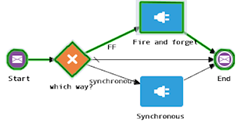Synchronous versus Fire-and-Forget Process to Process Invocation by Jan Kettenis
Blog: PaaS Community
 In the following article I explain why you should implement a Structured to Structured Process call as synchronous when you need that call to be recoverable in case of an issue.
In the following article I explain why you should implement a Structured to Structured Process call as synchronous when you need that call to be recoverable in case of an issue.
To call a Structured Process (that is initiated by a Message Start event) from another one, there are 2 ways to do so (actually there are 3 if you count in the Micro Process feature but that is a variation of one of these, I suspect the first):
- Using the /ic/api/process/v1/processes API
- Using the WSDL of the called process
I typically do the latter, as I find it to be simpler than using the API because importing the WSDL involves an automatic import of the XSD schema containing the request definition. Copy & paste of the WSDL URL and you’re done and when the interface changes, all I have to do is re-import the schema (in contrast, when using the API I have to manually figure out the proper JSON sample).
However, whichever way you use both concern a web service based interface, which you can configure to invoke in one of two ways:
- As Fire-and-Forget
- As synchronous (request/response)
Question is which one to use? The answer is simple: use synchronous in case there is no callback and you want to be sure the invocation either succeeds or can be recovered when it fails. If you don’t care, use Fire-and-Forget. Read on to find out why.
First let me point out the Fire-and-Forget Enterprise Integration Pattern. As it will tell you, in case of Fire-and-Forget error handling is not possible and you would need some Guaranteed Delivery mechanism to prevent the risk of losing messages. Mind that web service based invocation is not message based (which would involve using a Message Channel and with that typically an Invalid Message Channel to capture bad messages). So, in case of Fire-and-Forget there will be the risk of running into a non-recoverable error (hence the conclusion). OIC has no "magic feature" supporting recovery from failed invocations to Fire-and-Forget web services. And mind you, this is consistent with the pattern. Read the complete article here.
For regular information on Oracle PaaS become a member in the PaaS (Integration & Process) Partner Community please register here.
![]() Blog
Blog ![]() Twitter
Twitter ![]() LinkedIn
LinkedIn ![]() Facebook
Facebook ![]() Wiki
Wiki
Technorati Tags: SOA Community,Oracle SOA,Oracle BPM,OPN,Jürgen Kress
Leave a Comment
You must be logged in to post a comment.








